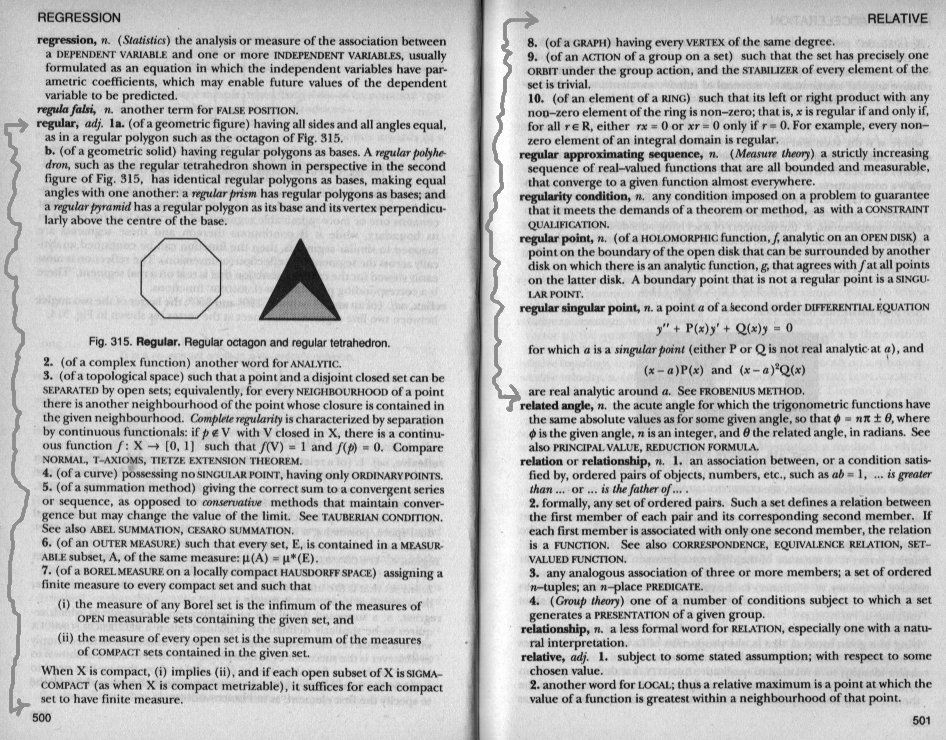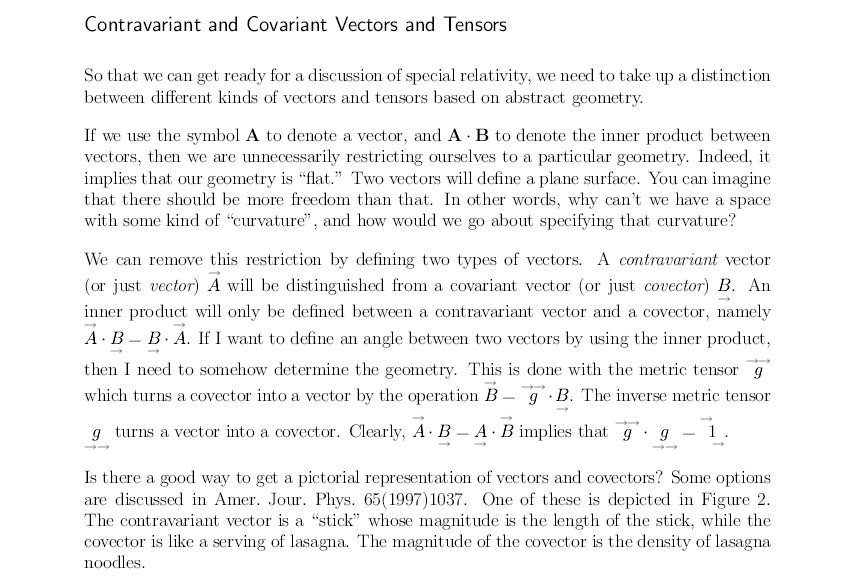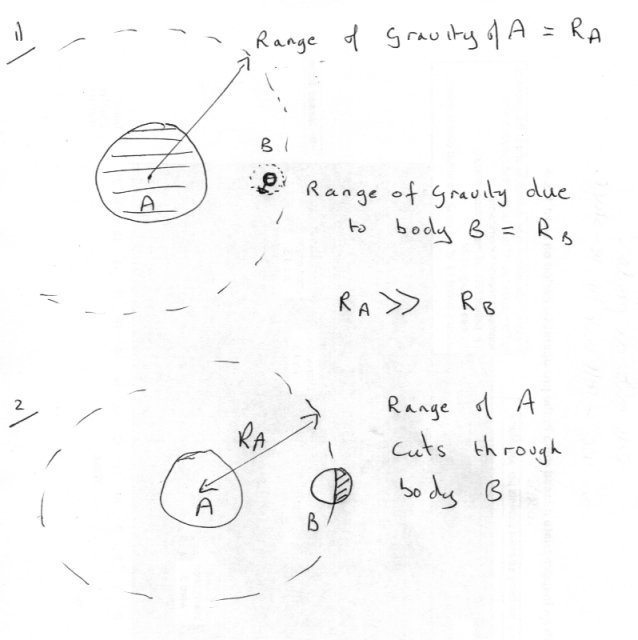-
Posts
18311 -
Joined
-
Last visited
-
Days Won
104
Content Type
Profiles
Forums
Events
Everything posted by studiot
-
I think perhaps we have a wood and trees scenario here. The principle points I wished to raise are. 1) The A and B are different. Space is not mass and mass is not space. 2) Any interaction introduces a third activity/agent such as my light paths.
-

What is more common in nature, regularities or irregularities?
studiot replied to Hrvoje1's topic in Applied Mathematics
I think the philosophers are better able to handle your proposals since these proposals do not match any of the many meanings mathematicians put the term 'regular' to. As you can see these are not 'trivial'. Since you want to stay mathematical which of these are you referring to? When we have established this we can further examine your use of the term "In Nature". Note that a crystal (or any array) can be imperfect yet have symmetry. Symmetry is not regularity. -
A word of advice. The mods here are very tolerant, but you are tweaking the noses of not one but two moderators If you continue I predict your dance here will be very short.
-
So what do you think this meant?
-
Space has no mass. I am using 'space' as a general term to mean distance, volume, area hyperarea and so on. Yes, which is why it can be difficult to impossible to show 'no interaction' when the possibilities are legion. Doesn't this also have implications for the "hidden variables" conjecture?
-
Let me try to put it another (hopefully simpler) way. Does A interact with B ? Well if I change A does that make any difference to B ? Yes: then there is an interaction. No: then B is independent of A or there is no interaction. OK so since you prefer to talk about mass let A be the space available to a system and B be the mass of the system. Further let B be divided into two parts separated within the system. There is a measurable and observable interaction between the two parts of B. We call this gravity. The model is irrelevent. If I change A so that the two parts of B are moved further apart, there is a measurable change in this interaction. Note the interaction between the two parts of is not the proposed interaction between mass and space, It is a way of measuring that interaction though. Similarly we can observe the light paths through the space. If we now change the distribution of mass the light paths can be observed to change. Again the additional interaction is not the proposed interaction between mass and space, it is just the means of observing it. So both ways we can confidently say that when we change either the mass, B, (or its disposition) or the space, A, something different can be observed in the other. So yes there is an interaction.
-
Yes. It is good to remember the rule What ever you do to one side of an equation you must do the same to the other side. So if you divide the 3x by 3 then you must also divide the 15 by 3, Just as you have done.
-
First read this extract about covectors. http://www.rpi.edu/dept/phys/Courses/PHYS4210/S10/NotesOnVectors.pdf Now look at pages 7 and 8 of this document https://www.grc.nasa.gov/www/k-12/Numbers/Math/documents/Tensors_TM2002211716.pdf These explains the connection between the dot product of two vectors, one a covector, and tensors in general, including the permeability tensor. See what you can get out of these two documents they are free to download.
-
Yeah, that's true it works rather like this:- In elementary electromagnetism we learn that the flux density vector B is proportional to the field strength vector H by the magnetic permeability μ, which is taken as a constant. So B = μH This is simply the multiplication of a vector by a scalar so the vector B points in the same direction as H. However the medium may not be isotropic so the permeability may vary with orientation or direction. So now we have three quantities which possess directional characterisitcs. The effect of this is that μ has to be regarded as an object which maintains the above equation. This cannot be a vector since the defined vector product of two vectors produces a vector perpendicular to their plane. The object that is needed is a rank 2 tensor and so the permeability becomes a rank 2 tensor. We can now regard μ aas a tensor of rank zero when taken as just a constant. Now you get a vector into the black multiplication box and the correct vector out.
-

The mechanism of the vertical circulation of the waters of the oceans
studiot replied to Fermer05's topic in Speculations
Yes indeed, the OP is not fond of responding to the words of others, he seems to prefer repeating his own. This may be in part because everything he does needs translation and his English is certainly miles better than my Russian. So I try to make allowances for this and guess what he actually means as sometimes his text contains inappropriate English words. But the fact remains that he has not acknowledged the principal mechanism for vertical exchange of water which is of course thermally drive by solar radiation energy. Warm water from the equatorial regions move polewards, cools and sinks. This would still happen if there were no astronomical tides at all. -

The mechanism of the vertical circulation of the waters of the oceans
studiot replied to Fermer05's topic in Speculations
Hi there. Yes the contribution from whirlpools is generally very small. But I am trying to make clear that the final water level and its changes has many contributing factors which may be large or small. One of these is often called the astronomical tide to distinguish from other factors. This is the one you describe here. With your pedigree you surely know what happens if you suddenly raise your backside in the bathtub. The water level oscillates up and down the bath, causing very substantial level changes at the ends in a sort of see-saw effect. A necessary result of this is a neutral point, called an amphidromic point, around the middle of the bathtub. https://www.google.co.uk/search?source=hp&ei=wlPRXK2-KoLCkwWz8K-4DA&q=amphidromic+point&oq=amphidromic&gs_l=psy-ab.1.0.0l10.1108.4136..9738...0.0..0.108.766.10j1......0....1..gws-wiz.....0..0i131j0i10.u1B3jwNZ5pg This is the simplest addition to the underlying tidal height. There are others that can also be large. -
How is that an answer to the question what would it do? Personally, depending upon model since we are apparently talking about all mobile phones, I would be more worried about liquid ingress through charging or other jack type sockets, (Mini/micro usb types should be able to resist this) or the effect on microphone and/or speaker components.
-
What would swansont's ionic solution do to the battery if you dunked the phone in? Surely if you must surround it with a liquid, you would use the double case or double bag method which would protect the phone from whatever liquid was used, whilst surrounding it with liquid?
-
My mobile has a plastic case, which is not wetted by mercury. I think it sufficiently mercury liquid tight that the liquid would not enter the case. How much mercury vapour is there in liquid mercury? My answer is as serious as the question. If the OP wants to shield a phone why not use an ordinary solid metal box of thick enough gauge? There will be no mobile signal inside such a box. Why put it into contact with a liquid?
-
If you want a liquid to block off the mobile phone immerse it in mercury. Note this liquid is toxic to humans but not mobile phones.
-

The mechanism of the vertical circulation of the waters of the oceans
studiot replied to Fermer05's topic in Speculations
That is not abnormal. What would be abnormal would be for the water level change in a restricted region to be less than corresponding values from the open ocean. Ther's a lot more to it than that, principly the interaction of the forcing function and the topography whther resonance or anti-resonance or even more exoitic effects such as the 'double tide' in the Solent. -

Solve complicated second order differential equation
studiot replied to Miguel_s's topic in Analysis and Calculus
Since you only have two variables I agree with mathematic that this is an ODE. I would proceed as follows: Replacing all your constants and collecting them together, you only need 3 constants. I have started with four, A, B, C and D and finally added E = B/A [math] - \frac{d}{{dr}}\left( {\varepsilon r\frac{{d\varphi }}{{dr}}} \right) = B{e^{ - \left( {C\varphi + D} \right)}}[/math] [math] - \varepsilon \frac{d}{{dr}}\left( {r\frac{{d\varphi }}{{dr}}} \right) = B{e^{ - \left( {C\varphi + D} \right)}}[/math] [math]A\frac{d}{{dr}}\left( {r\frac{{d\varphi }}{{dr}}} \right) = B{e^{ - \left( {C\varphi + D} \right)}}[/math] [math]A\left( {\frac{{d\varphi }}{{dr}} + r\frac{{{d^2}\varphi }}{{d{r^2}}}} \right) = B{e^{ - \left( {C\varphi + D} \right)}}[/math] [math]\left( {\frac{{d\varphi }}{{dr}} + r\frac{{{d^2}\varphi }}{{d{r^2}}}} \right) = E{e^{ - \left( {C\varphi + D} \right)}}[/math] -

Solve complicated second order differential equation
studiot replied to Miguel_s's topic in Analysis and Calculus
It would be a lot easier to understand and be sure of your notation if you provided a symbols key. is FcH+c meant to be (F) (cH+)c ? Have you plotted a direction or characteristic field for the equation? -
You have quoted 3D coordinates so the function f(pn) will be a surface or even a hypersurface, depending upon your intention,, unless you actually meant something different. So the question of 'strictly increasing becomes more difficult as it depends upon the direction you approach the point from. Can you clarify whether your function is F = f(x1,x2,x3) or does one of the x values represent a dependent variable?
-
I suppose generally the understanding might be an exchange of some sort that effects both to some degree Here's an example of what I mean. Take a pair of conductive plates with some space between them. Add some (electrical ) energy Now move the plate further apart. Are the changes to the physical properties of the system an interaction between the energy and the change in space, since nothing else has changed?
-
Yes, why wouldn't it? But it would also depend on your understanding of the term 'interact'
-
There are also artifical stone products like corian and other trade makes. These are made from ground up natural stone/rock material as filler bound in a polymer resin base. So they are solid right through, unlike Formica type laminates which still have a plywood/particle board core. http://www.corian.uk/?gclid=EAIaIQobChMI-duY5Zn94QIVA4fVCh1Qfge4EAAYASAAEgL_U_D_BwE And, of course there is always stainless steel.
-
And in that thread I asked you a simple geometric question you failed to reply to. Last time the question was posted in terms of velocity and dynamics. But the geometric difficulties remain in statics. I take it you will agree three things, which are all straight forwardly observed in Newtons gravity. 1) That for any body the greater the body the greater the body's gravitational effect on other bodies. 2) That if body A affects body B then body B affects body A. 3) That the influence of body A affects every part of body B. You have added the proposal that there is some fixed finite range for the gravitational effect of a body. So how does this range vary with distance from the body? Does the range increase with body mass size, like the force effect in rule 1? If so then my fig 1 shows how two bodies of different sizes break rule 2. That is for A >B, body B can be inside the radius of inference of A, whilst body A remains outside the radius of influence of B. Further fig 2 shows where the range of Body A passesnthrough body B dividing it into 2 zones. So how do you treat this? What mass do you use in the calculation? Does the gravitational effect of body A extend beyond its range into the shaded parts of body B?
-

The mechanism of the vertical circulation of the waters of the oceans
studiot replied to Fermer05's topic in Speculations
You need to be clear what you are talking about here. You need to distinguish between the natural 'astronomical tide' which is simple the effect of the Moon's and, to a smaller extent the Sun's, gravity, acting vertically. Superimposed on this is the horizontal movement of water, also due to the orthognal component of this gravity. This horizontal movement is conditioned by seabed topography. In estuaries the channel narrows and the bed shoals so the incoming water has no place to go other than up. This results in an increase in tidal heights over open water values for similar locations. Further complications occur due to the periodicity of the forcing function, especially if resonance occurs as in the case of Fundy where the resonance leads to an increase of about 15 metres height. I posted some data for the North Sea, in your last thread, showing similar resonances leading to some coastal areas experiencing increased heights of a few metres. Yet more complications arise if the topography and timing is such that non linear oscillations can occur. This leads for instance to the Severn Bore, adding a further 2.5 metres to the 15 metres rise in the Severn estuary. Gyres are an entirely different phenomena which require deep water to operate. They are the mechanism which connects the deep water ocean circulation currents with those nearer the surface.




